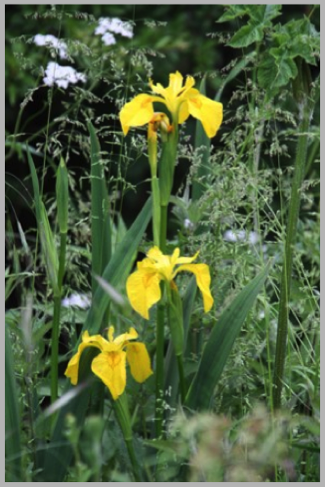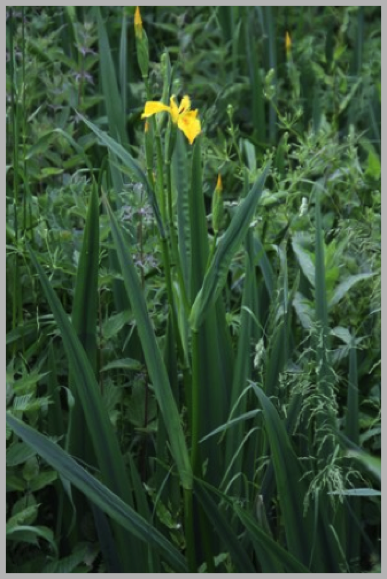Yellow flag Iris
Found from May to July
on Circular Walk No.1
at grid reference: SP4168 1350
Notes by Martin Marais

Yellow flag (Iris pseudacorus) is a species of iris that that is native to Europe, western Asia and northwest Africa. It has many common names in Britain including yellow iris and flag iris. More unusual names include variations of an Anglo-Saxon word meaning "Sword", such as Segg, Cegge, Seggin, Skeggs, Sheggs or Yellow Saggen. These are believed to refer to the Sword-shaped leaves.
The name flag is thought to derive from the fluttering of the flowers blowing in the breeze resembling flags. Its scientific name, pseudacorus, means "false acorus" and refers to the similarity of its leaves to those of plant called sweet flag or calamus (Acorus calamus) which is a rather dull plant in comparison. However, sweet flag has a scent to compensate for its dull green flowers, while yellow flag, for all its showiness, has no scent.

Yellow flag grows best in wet conditions such as the margins of ponds and streams
(for example on Circular Walk-1 near the brook on the Hanborough Footpath FP9 shown by the leaf symbol on the map at left). It is found in similar places to bulrush and often grows with it, though usually in less deep water.
While it is mainly an aquatic plant, the rhizomes can survive dry conditions during times of drought. The plant can spread quickly by both rhizome growth and water-dispersed seed. The flowers appear from May to July.
The rhizome has been used since Roman times for herbal remedies, in particular to induce vomiting. Juice from the rhizome has also been used to treat sores and pieces of rhizome used to be placed on aching teeth to ease the pain. Other uses for the rhizome have included treatments for diarrhoea, period pain, convulsions, dropsy, bruises and ulcers. Dried, powdered roots were made into snuff to clear head colds or the juice from the crushed roots spooned into the nostrils.

The plant has also been used in poison antidotes, particularly against the bite of a mad dog. It has also been used for water treatment as it can take up heavy metals through its roots.
Yellow flag flowers also used to be hung over doors to ward off evil spirits.
flowers yield a yellow dye and the roots a black dye, which is used to make an ink called Sabbath Black. A bright green dye can be obtained from the leaves. All these colours have been used for colouring Harris Tweed in Scotland.
Some believe that the yellow flag is the flower represented in the fleur de lys.
© Martin Marais 2010